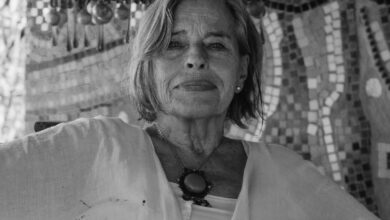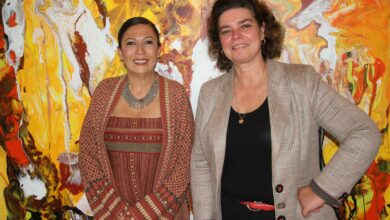Although art is generally perceived as an exclusive discipline with limited outreach, Egyptian curator Sarah Rifky argues that the boundaries of the discipline can be occasionally broken. “The state and even security apparatus have always been part of the public of art,” she said.
Sherif al-Azma, a video artist who teaches at the American University in Cairo’s Performing and Visual Arts department, believes in “revolution as a daily practice”–one that starts within individuals, at home, at work and all over the city and that continues beyond times of crisis. For years artists have been working within the system as well as on grassroots levels, trying to show people alternative ways of seeing and experiencing the world and envisioning a different future.
The power of artistic discourses is evident in numerous attempts by the state to censor artwork and detain artists. In 1949, Egyptian artists Hussein Youssef Amin and Abd al-Hadi al-Gazzar were arrested because of the latter’s painting “Hunger” (later re-titled “The Theatre of Life”), which showed Egyptian people from various socio-economic backgrounds lined up against empty eating plates. The painting was considered an attack on the political regime.
In the years following the 1952 military coup, the state managed to exercise full control over artistic and cultural production as private art patrons disappeared, the state became the primary employer of artists, curators and critics. Phone networks and the press were nationalized in May 1960. Artistic production was deployed to cater as the mouthpiece of the state, spreading revolutionary propaganda to provide legitimacy to political groups in power at the time.
Nevertheless, many artists continued to build public awareness around socioeconomic and political conditions in Egypt–albeit, in more subtle ways. Some, such as Egyptian artist Ahmed Bassiouny, joined the state bureaucracy and worked on introducing reforms from within the system. Bassiouny passed away on 28 January 2011 after being shot five times and run over by state security forces in pro-democracy demonstrations at Tahrir Square. Bassiouny taught at the Faculty of Art Education at Helwan University. As a university professor, he introduced his students to new artistic concepts and ran workshops on digital, live and sound art. “He was highly influential through his artistic practice and taught his students unconditionally,” explained al-Azma. “Yet he was killed by the same regime he served.” Regardless of one’s political beliefs, he said, there was no turning back. “The fight has become personal as well as political with the loss of friends and family members,” he added.
Last May, Rifky curated an exhibition titled “Invisible Publics” at Downtown Cairo’s Townhouse gallery. The exhibition reflected a recurring theme in Rifky’s practice: the exploration of what constitutes a “public” and ways of activating it. “Invisible Publics” explored the possibility of action that arise when people convene in an exhibition space, which served as a metaphor for public space in general.
Inspired by the writings of German political theorist Hannah Arendt, the exhibition’s curatorial statement discussed how exhibition space is temporarily transformed into a public space through the “essential human condition of plurality.” This condition according to Arendt exists ''whenever men are together in the manner of speech and action, and therefore precedes and predates all formal constitution of the public realm and its various forms of government.''
Rifky does not see herself as a political activist. She is, however, politically active through her curatorial practice, which she envisions as a “think tank, an incubator of ideas, a theoretical field of investigation that tries to analyze and make sense of the world.” The opening performance to the exhibition was a local rendition of the “Complaints Choir,” dubbed “Cairo Complaints Choir.” An open call was made for people of all backgrounds to participate in a week-long workshop, during which complaints would be gathered, rephrased as lyrics and rehearsed as songs. Most of the participants had no artistic or musical background.
Rifky, who was out of the country when the pro-democracy demonstrations began on 25 January, began acting as a focal point for the dissemination of information online through Twitter and Facebook as well as through international phone calls during the internet outage in Egypt. Information about safety points, curfews, utilities and helplines became a valuable and inaccessible asset, she explained. “I began spreading the word in Cairo and other governorates through friends about SpeakToTweet”–an international phone line service that allows people to call in and leave voice news feeds and listen to those made by others. Once she was back in Cairo, she began providing real-time services, giving directions to people and verifying helpline numbers that were spammed with incorrect ones. “It feels like being conscribed over the past two weeks. I’ve been masquerading as a citizen reporter, journalist, humanitarian, human rights activist. I’d also be happy when I can start working on the analytical side of things.”
Choreographer and contemporary dancer Adham Hafez has been working for years with professional dancers and amateurs on exploring ways of self expression through the human body. Through HaRaKa Dance Research and Development Project, which works on theoretical research, translation of texts as well as experimental workshops with the public, Hafez has been highlighting the human body as a “critical site or tool for self-expression” within a specific political context. Over the past year, HaRaKa has been organizing mini-festivals titled Transdance in various places that propose a trans-disciplinary approach to dance and movement. Working with a group of local and international artists, the festivals highlighted how ideas transform into physical performance.
Since the beginning of the protests, Hafez has been studying closely the change in the nature of public space and its accessibility. “Demonstrations lie in the performative realm,” he explained. “Protestors, including myself, are performing and physically embodying what they want to say,” he added. At Tahrir, workshops are being held and a friend held a puppet theatre “Aragooz” with the people there–another forum through which the protestors express themselves.
Hamdy Reda, an Egyptian photographer and founder of Artellewa art space in Ard al-Lewa, participated in the demonstrations every other day, documenting all that was happening. “I believe in the value of the visual image. This is why I take photographs wherever I go,” he explained. In the case of the pro-democracy demonstrations, photographs act as a historical document and evidence of what is happening, which can be used in the future by artists, lawyers and human rights groups as proof to what really happened, he added.
The value of his photographs were even acknowledged by National Security Forces and military officials, who detained him on Thursday 3 February, one day after the violent confrontations in Tahrir between pro-Mubarak protestors, hired thugs and the pro-democracy demonstrators. Dubbed “Black Wednesday” in reference to the large number of casualties that fell on that day when knives, bludgeons and live ammunition was used by the pro-Mubarak demonstrators against demonstrators at Tahrir, Reda had succeeded in documenting on his camera the violence which started on Wednesday afternoon and lasted until the early hours of Thursday morning.
As he headed home on Thursday morning, Reda was stopped at a checkpoint by National Security officers by the Egyptian Trade Union Federation. Slapped, spat at and accused of high treason as an Israeli, then an Iranian, spy, Reda was photographed and detained at the building of a major state owned newspaper on al-Galaa Street, where his memory cards were taken. There, he was harassed by journalists, the building’s security and thugs.
After he was released on the following day, Reda began working on spreading awareness in his neighborhood about the Tahrir protests as many people remained confused by “conspiracy theories” promoted on a number of TV channels. He also began working on creating social solidarity networks for the impoverished in the area, who were suffering the most from opportunistic hikes in food prices and primary goods.
As a video artist, al-Azma believes there was little he could contribute to the “ongoing media circus.” “We are currently at a state of suspension and cannot see the bigger picture,” he added. Hence, we need to find ways of introducing reforms beyond the symbolism of Tahrir square.
A group of artists convened last Monday at the Cairo Atelieur in Downtown Cairo to discuss roles they can play collectively. One idea was assigning a group of volunteer artists and architects to work on rehabilitating Tahrir square. Egyptian musician Fathy Salama suggested collecting testimonies from artists, who have been harassed and censored by the Ministry of Culture and Interior over the years, to press charges. Some even suggested creating new syndicates for artists in order to create a legal body to work on reforms and advance artists’ interests.
“There’s a change in protest culture, but there’s a need for more dialogue,” explained Reda. For the uprising to succeed, “people need to be mobilized and act on all levels: municipalities, syndicates and ministries.”
What is generally agreed upon is that the Tahrir protestors cannot propel the transformation single handedly. People must begin taking personal responsibility and become invested in change. “It’s not just about creating a sense of solidarity, but people should work within their professions and at home on change. This is much more valuable and valid to instigate change.”




